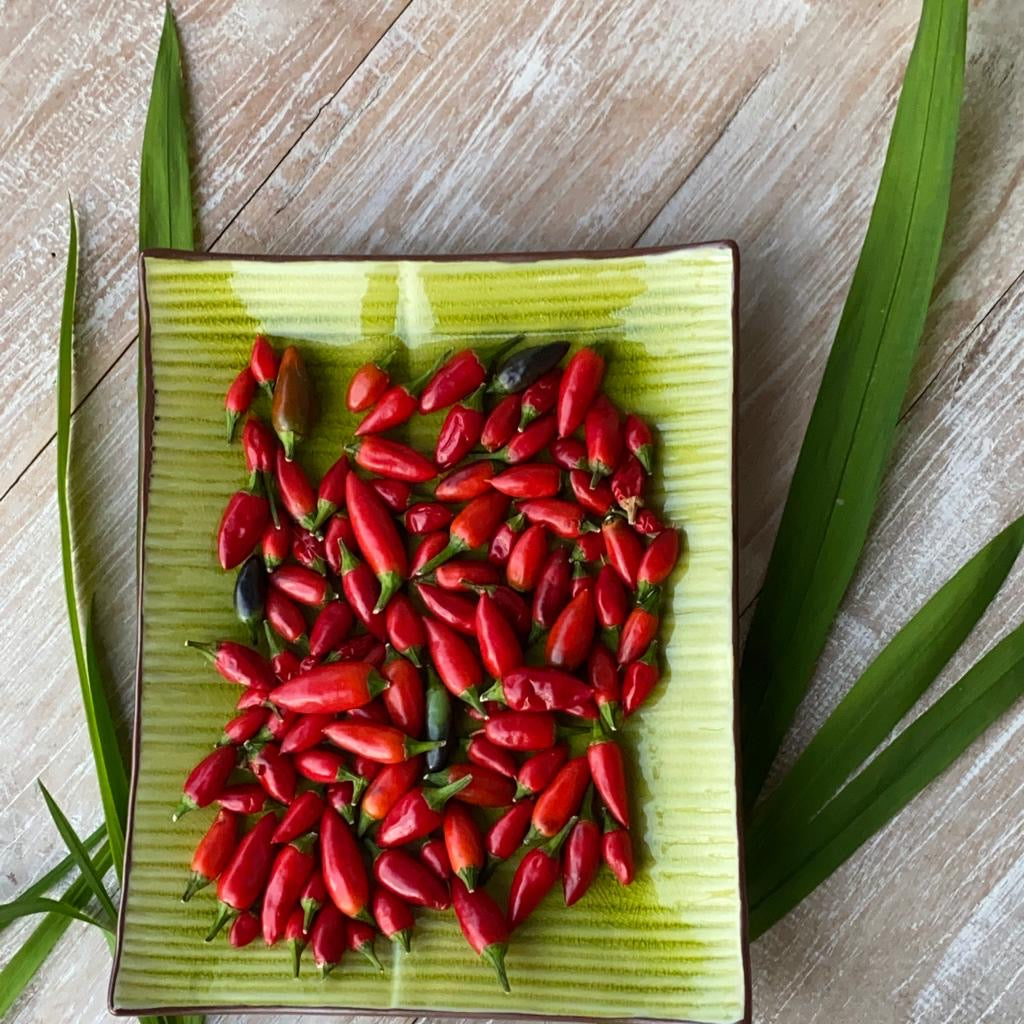Chilli - The King of Spices & How it is used in Indian Cuisine
By Conchita de Souza

Nothing can be as synonymous with spice as the chilli, with many cultures seamlessly adopting it into their cuisine because of the powerful punch it adds.
In our post today, we explore the origins of the chilli, examine what makes chilli ‘spicy’, understand how ‘spiciness’ is measured and delve into how the chilli made it into India and Indian cuisine over time.
The Origins & Classification of Chilli
Chillies are said to be native to Mesoamerica (the central regions of the Americas) where they have been cultivated and used for over 7,500 years. In addition to flavouring food, chillies were also used as a means of preserving food as it would keep it from spoiling.*
As deceptive as it may seem, chillies are botanically classified as a fruit because they bear seeds. Specifically, they are classified as a berry!

Image: Young chillies growing in our garden
Vegetables are the plant itself, or the edible part of a plant, which does not comprise the fruit. We won’t go into any further details about what classifies something to be a fruit and a vegetable. Instead, we will direct you to this article by Merriam-Webster to better understand the difference between the two.
In some parts of the world, chillies are referred to as peppers since the pungency of the chilli was likened to that of the little black spice pepper, though there is no connection between the two botanically. To add to the confusion, the scientific name for chillies is capsicum annuum with its milder sibling (what we call capsciums or bell peppers) called capsicum frutescens.
Capsaicin - The Spice Compound
Capsaicin is the compound contained in most chillies and is responsible for the burning sensation one feels when consuming them. This burning sensation is triggered by our bodies’ pain receptors, specifically the temperature sensation receptor TRPV1. When the capsaicin compound is detected on our tongue it trips the pain receptor whose function is to detect anything that is unsafely hot. Hence, our mouths literally feel like they are on fire because TRPV1 has kicked in and tells us to stop eating the little devil. Having learned the hard way, I now always thoroughly wash my hands with soap after chopping chillies. This habit came after having unintentionally rubbed my eyes after chopping chillies and succumbing to the burn!
When scientists delved into why this was the case, they discovered that the presence of capsaicin in chillies is the plant’s evolutionary defence mechanism to prevent herbivores like mammals (and humans) from consuming them. Interestingly, birds seem to be immune to capsaicin and do not have receptors in their mouths to detect its presence.
The reason being that unlike mammals, whose teeth grind down the seeds of the chilli, birds consume the plant without disturbing the seeds. They also help with dispersing the seeds far and wide thus allowing the plant to propagate and thrive amongst all the other plants out there.
You can click here for a more scientific discussion on the evolutionary history of chilli.
Scoville Scale
Now that you are aware of why chillies are spicy, it is time to explore how spice is measured.
You may have heard of the Scoville Scale, named after scientist Wilbur Scoville. This scale measures the pungency of spicy foods including chillies by determining the concentration of capsaicin it contains. More scientifically accurate tests have been since developed, however this scale is still widely used despite it relying on human subjectivity.
It originally worked like so:
A solution of the pepper extract is diluted in sugar water until the 'heat' is no longer detectable to a panel of (usually five) tasters; the degree of dilution gives its measure on the Scoville scale.**
To give you a practical understanding, we have done a very basic ranking below:
- The ordinary Capsicum has a rating of 0 Scoville Heat Units (SHU).
- A Jalapeno sits between 2500 - 5000 SHUs
- Tabasco ranks between 30,000 and 50,000 SHUs
- Birds Eye Chilli, commonly used in Asian cooking, sits between 100,000 - 225,000 SHUs
We are still at the lower end of the spice scale! If you really want to turn up the heat, the Naga Bhut Jolokia Chilli or the Ghost Pepper, hailing from the north-east region of India ranks at a whopping 1,041,427 SHUs! It has even been used as a biological weapon by the Indian Army in the form of gas grenades against terrorists.
Have a read of this website for a detailed list of how different chillies and hot sauces are rated on the scale.
Chilli Arrives in India
Chilli has become central to Indian cuisines in the past five centuries, however Indian cuisines were never lacking in spice itself. Indian foods have always had punch to them, and that is attributed to the use of ingredients like pepper and ginger.
Christopher Columbus stumbled upon chillies in his quest to establish trade routes through Asia in order to access the coveted pepper, a prized commodity that was known as ‘black gold’ because it was used to pay rent and salaries.***
Chilli was supposedly brought to India through the Portuguese explorer Vasco Da Gama, who had forged a route from Brazil to Africa and India. The Portuguese took over Goa in 1510 and this small region on the west coast of India became a port for the trade in spices between India and Europe. Indians took to the chilli plant easily as they were no strangers to spices!
It may not come as a surprise to you that India is now the world’s largest producer and exporter of chilli. As mentioned earlier, it also boasts of the Ghost Pepper, verified as one of the hottest peppers around.
Chilli in Indian Cuisine

Image: Tempering the chilli along with other whole spices
Chilli now plays an important role in many regions and cultures of India, extending beyond the realm of food to religion as well. They can be consumed fresh, dried and put into tadkas, flaked and added as a garnish (though chilli flakes are more of a Western thing) or powdered to form part of a masala.

Image: Chillies in their dried, flaked and powdered forms
A popular street food item is mirchi pakoras, where the milder and larger chillies are dipped into a spicy batter of chickpea flour and deep fried. They make for a delicious snack along with a steaming cup of masala chai.
Many Indian meals are accompanied by the holy trinity of fresh garnishes - pyaaz, nimboo and mirchi in Hindi - onion, lemon and chilli. Each of these fresh ingredients adds the elements of crunch, acidity and heat to balance a meal.
Other Uses of Chilli in India

Image: @kristina_intercultural
If you have ever been to India, a common sight is that of lemon and chilli strung in entrances of shops or on vehicles (pictured below). It is an odd sight to see and our research leads us to believe that this practice is based on a mix of tradition and science.
The lemon and chilli are rich in Vitamin C. When pierced, the fluids would mix with the air and spread to repel those ghastly mosquitoes and flies. The chilli would help with expelling any germs in the air thanks to its remedial properties.
Another explanation for this is that in olden times, when journeys by road were a lot more hazardous and lengthier than they are now, people would carry lemon and chillies as they traversed through jungle terrain. The lemon would be squeezed into water and drunk and both the chillies and lemon would help to determine whether a snake bite was lethal or not. If the victim could taste the spice from the chilli and the sourness of the lemon, the bite was not lethal, but if they were immune to those sensations, then the bite was lethal and they would need to take medication urgently. The reasoning being that the nerve endings would be paralysed from a snake bite and therefore one could not experience taste!
Nowadays, this combination is like a lucky charm to ward off any negative energy or bad luck.
We hope that this post has given you some insight into this small but potent ingredient and how it has been embraced by Indians especially. It has sure been a spicy ride so far, and to end on a sweeter note, why not try our recipe for this sweet, spicy and tangy Chilli Jam that makes a great accompaniment to many dishes and is packed with flavour.
References
*Adams, C (2012) The Complicated Evolutionary History of Spicy Chilli Peppers http://sitn.hms.harvard.edu/flash/2012/issue131b/
**https://www.chilliworld.com/factfile/scoville-scale#The Scoville Scale
***Ettenberg, J (2020) A Brief History of Chilli Peppers https://www.legalnomads.com/history-chili-peppers/

1 comment
Great Information, as an indian always wondered how much Scoville was in our food. But Honestly the South Indian food much more Scoville Units than north Indian food. Only if we could calculate that.
Thanks for the post. Good Read.